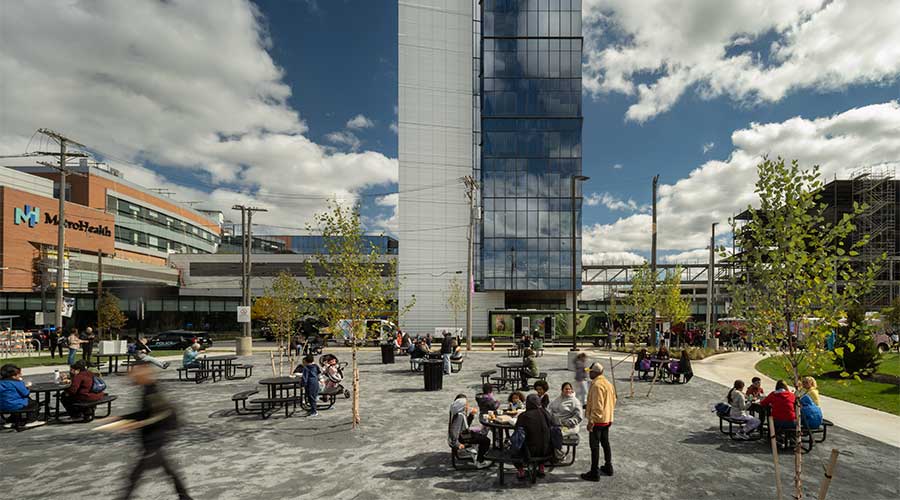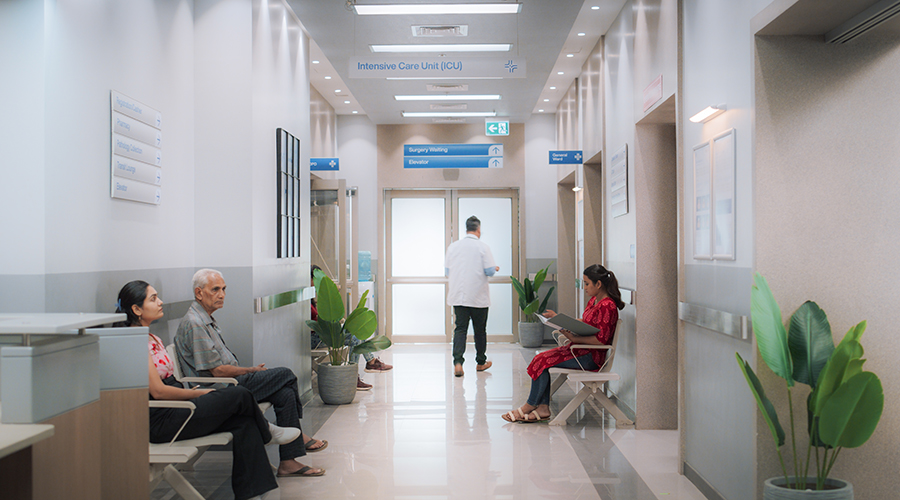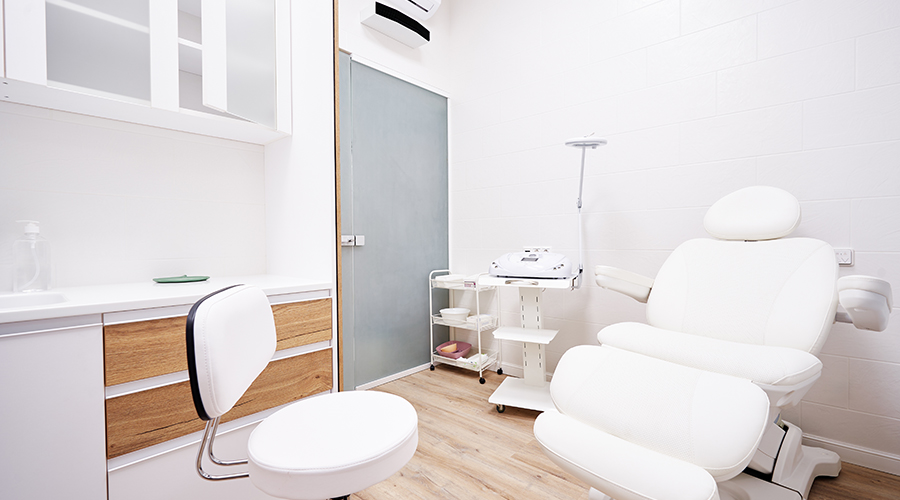HGA has completed MetroHealth System’s replacement hospital, The Glick Center, in Cleveland. HGA reimagined the master plan of MetroHealth’s campus transformation and led the planning, architecture, interior design and engineering of the 11-story acute care hospital.
MetroHealth’s transformational campus plan emphasizes diversity, population health and research-based care. The new inpatient tower is cost-effective, sustainable and patient focused. When the campus is complete, it will be grounded in a restored, natural urban setting.
Design inspiration
The design of the building drew inspiration from historical photos of the first hospital, which had been set in a park. The white terracotta exterior façade reflects the traditional material used on the MetroHealth Hospital at the beginning of the 20th Century and was reimagined using contemporary building methods. The innovative cladding system was prefabricated on the ground and hung from a unitized curtain wall system, making assembly safer and faster.
The wave-like profile of the terracotta panels echoes nearby Lake Erie and the Cuyahoga River. The panels have a more turbulent and textural response at the public interface at grade and quiet as the building rises. The narrow end of the inpatient tower orients towards the residential Clark-Fulton neighborhood to reduce its visual impact and scale.
Numerous studies have found that patient recovery iss faster and more complete when subjects were exposed to natural environments. The interplay of light and shadow found in tree canopies is abstracted in the design through the texture of the building cladding, numerous skylights, and textured wall tile.
The building responds to the lack of green space in the Clark-Fulton neighborhood by becoming a Hospital in a Park and Hospital as a Park to support informal, park-like activities, through visual cues such as biophilia and the inclusion of a dedicated performance space in the public lobby for dynamic community performances. Additional park symbolism includes green grass-like carpeting with undefined edges, cartography in the terrazzo, picnic patterns in the servery and a large, simulated window with view of the Ohio landscape.
“Taking design inspiration from its culturally rich urban neighborhood on Cleveland’s West Side, we worked with HGA landscape designers to create a series of landscaped parks, inspired by the historical roots of the area, including industrial salt and gravel mounds,” says HGA senior designer Bryce Hubertz.
In MetroHealth’s meditation area, a piece by local artist Susan Danko uses calming colors and leaf and branch forms to add to the feeling of serenity in the space. These nature and park concepts extend to MetroHealth’s youngest patients.
The Peds Platform, or Tree House, is a play and breakout space for children to take their minds off being in the hospital. The inspiration was an actual tree house, designed to feel immersed in a jungle or forest canopy and includes an outdoor space. The Tree House provides children with a sense of freedom and control in a situation that can otherwise feel daunting.
Health, the arts and the campus
MetroHealth is transforming health and healing through the arts. It created The Center for Arts in Health in 2015 with a mission to embed visual, performing and therapeutic arts throughout MetroHealth. MetroHealth is integrating an extensive art program throughout its new facility that benefits every staff member and visitor, from the youngest to oldest, and connects the hospital to the community. The new main lobby converts to an amphitheater for fine arts programs and performances that will please patients, families and the public, who may not otherwise be exposed to these types of programs.
“MetroHealth Glick Center will benefit from an integrated approach to the arts and health through dedicated physical space and programs,” says Linda Jackson, director of the center for arts in health at metroHealth. “Whether it be music, dance, theater, visual arts, wall art installations or community arts programs on nature, artists will be able to create a truly extraordinary experience for MetroHealth’s patients and community.”
The West 25th St corridor and the adjacent downtown neighborhoods have an abundance of colorful public murals used as a visual expression of Cleveland’s culture. The hospital infuses these colors in dichroic partition glass and furniture within its public spaces to connect to its cultural context.
On the main stairs, a bright and colorful mural by artist Ariel Lee depicts Ohio’s Cayuga Valley and connects to the park setting beyond. Cleveland artist, Lynnea Holland Weiss’ mural of two figures in an embrace emphasizes the support, hope, and healing nature of MetroHealth and will hang in the main dining space.
A sculpture of acrylic discs by artist Emmanuelle Moureaux is suspended from the ceiling of the dining hall and mimics the sunlight that flows into the space through the large windows. Each piece selected by Linda Jackson and her team has a common theme: bright colors, positive imagery and a nod to locality to help patients feel at home and find inspiration in their healing process.
Flexible planning for long-term value
In a forward-thinking response to rapid changes in improved patient care and to streamline staff efficiencies, an evidence-based, lean, and data-driven planning approach led to a Process Neutral design approach.
The placement of new interventional procedure rooms, cardiac catheterization labs, and endoscopy procedure rooms adjacent to the existing room surgical suite creates a flexible interventional platform. All-day stay patients are cared for in highly adaptable, universal pre-op, PACU and Phase II recovery spaces that respond to changing census and patient needs. Room features afford privacy and hotel-like amenities for patients and families during their stays. The burn unit provides inpatient treatment and an outpatient clinic and shares a floor with the stem cell unit. The flexibility of the floor plate allows for a unique configuration of the core workspace to meet the unique needs of these departments.
A single family center replaces individual family waiting rooms on every floor. allowing even more flexibility to adapt patient floors when change inevitably comes. This family resource destination welcomes families and visitors, offers a variety of privacy levels, concierge level information services and a family-like kitchen for prepping meals.
Hospital-led sustainability
Sustainability planning sessions and a resiliency assessment were conducted before design began and carried through into design. The results are significant energy savings, gas reduction, carbon dioxide reduction and MMBtu reduction. The transformation includes improved water management, by reducing consumption in a water intensive environment and using stormwater as a resource onsite.
While creating community connections, the master plan considered the impact of sound, exhaust smells, and lighting both for safety and elimination of light pollution emanating from the building into the park. Inside, health and wellness is supported through advanced air filtration, daylighting, lighting controls, and additional essential systems power.
The new hospital will be LEED certified and seek Well Building certification.

 Social Media Driving Rise in Trade Jobs
Social Media Driving Rise in Trade Jobs North Carolina Children's Receives $25M Gift from Coca-Cola Consolidated
North Carolina Children's Receives $25M Gift from Coca-Cola Consolidated Swinerton Breaks Ground on $5.5M Medical Office Building in North Carolina
Swinerton Breaks Ground on $5.5M Medical Office Building in North Carolina Rethinking Strategies for Construction Success
Rethinking Strategies for Construction Success From Touchless to Total Performance: Healthcare Restroom Design Redefined
From Touchless to Total Performance: Healthcare Restroom Design Redefined